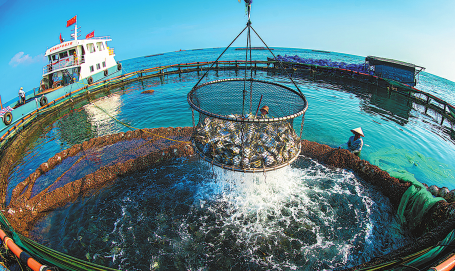Overseas demonstration zones strengthen cooperation in sector

A deep-sea fishing and seafood station in Guangxi. CHINA DAILY
Agricultural authorities in South China's Guangxi Zhuang autonomous region offered strong financial and policy support during the 13th Five-Year Plan (2016-20) for local companies to open up new overseas markets and participate in the construction of the Belt and Road Initiative.
Since 2018, they have supported companies to build six agriculture cooperation demonstration zones in Vietnam, Laos, Cambodia and other members of the Association of Southeast Asian Nations. Also, three domestic agricultural opening-up and cooperation zones have been established in the border cities of Pingxiang, Baise and Dongxing.
These zones, serving as service platforms and communication channels, have helped a group of Guangxi agricultural companies expand businesses in ASEAN countries by constructing raw material bases and agricultural products processing factories.
By the end of 2020, a total of 114 agricultural companies in the autonomous region had located projects in foreign countries, with contract investments reaching $3.36 billion. Many of the projects have become indicators of high-quality development that combined China's new crop varieties, technologies and production models with foreign countries' advantages in natural resources.
Hiseaton Fisheries, for example, has developed deep-sea offshore aquaculture in Brunei by using China's advanced captive breeding technologies. It has formed a modern fishery industry system covering hatching, breeding, acquisition, processing and marketing. Its aquatic products have been welcomed by customers from the European Union, Japan and North America.
In overseas agriculture cooperation demonstration zones, companies are encouraged to cobuild and share infrastructure such as roads, cold storage and logistics services, in a bid to lower the early-stage investment, avoid repeated construction and better attract companies lacking experience in international cooperation.
Backed up by these demonstration zones, more companies have enhanced their strength and international competitiveness. Guangxi Wanchuan Seed Co, for instance, invested in vegetable and paddy rice projects in Vietnam. It has signed a cooperation agreement with the country's largest listed seed company and set up long-term partnerships with some smaller seed firms.
Wanchuan annually exports 2,000 metric tons of rice and vegetable seeds to Vietnam, with a total export volume exceeding 76 million yuan ($11.9 million). It now ranks first in China in the number of exported seeds to ASEAN countries.
Over the past five years, Guangxi has established five crop variety test stations in ASEAN countries to help promote the application of the autonomous region's seeds, technologies and equipment. They have also boosted in-depth communication between the two sides in agricultural sciences.
The five stations have introduced and tested more than 400 new agricultural varieties from Guangxi. They then selected 120 varieties that are suitable for growing in those countries.
In Laos, for example, the station has transformed agricultural history by reversing the country's inability to grow cantaloupes.
By using Guangxi's rainproof cultivation technologies, as well as soilless culture and integrated management of water and fertilizer, the fruit has been successfully grown.
The Cambodian station has introduced a smart management system to help the country realize automatic management in agricultural production, such as soil moisture control, climate monitoring, remote control and product traceability.














